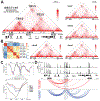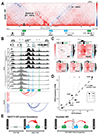Dissection of a CTCF topological boundary uncovers principles of enhancer-oncogene regulation
- PMID: 38452764
- PMCID: PMC10997458
- DOI: 10.1016/j.molcel.2024.02.007
Dissection of a CTCF topological boundary uncovers principles of enhancer-oncogene regulation
Abstract
Enhancer-gene communication is dependent on topologically associating domains (TADs) and boundaries enforced by the CCCTC-binding factor (CTCF) insulator, but the underlying structures and mechanisms remain controversial. Here, we investigate a boundary that typically insulates fibroblast growth factor (FGF) oncogenes but is disrupted by DNA hypermethylation in gastrointestinal stromal tumors (GISTs). The boundary contains an array of CTCF sites that enforce adjacent TADs, one containing FGF genes and the other containing ANO1 and its putative enhancers, which are specifically active in GIST and its likely cell of origin. We show that coordinate disruption of four CTCF motifs in the boundary fuses the adjacent TADs, allows the ANO1 enhancer to contact FGF3, and causes its robust induction. High-resolution micro-C maps reveal specific contact between transcription initiation sites in the ANO1 enhancer and FGF3 promoter that quantitatively scales with FGF3 induction such that modest changes in contact frequency result in strong changes in expression, consistent with a causal relationship.
Keywords: ANO1; CTCF insulator; DNA methylation; FGF3; FGF4; SDH deficiency; chromatin; enhancer regulation; gastrointestinal stromal tumor; genome topology.
Copyright © 2024 Elsevier Inc. All rights reserved.
Conflict of interest statement
Declaration of interests B.E.B. declares outside interests in Fulcrum Therapeutics, HiFiBio, Arsenal Biosciences, Chroma Medicine, Cell Signaling Technologies, and Design Pharmaceuticals. V.Y.G. and A.S.H. have filed a provisional patent on RCMC.
Figures




References
MeSH terms
Substances
Grants and funding
LinkOut - more resources
Full Text Sources

